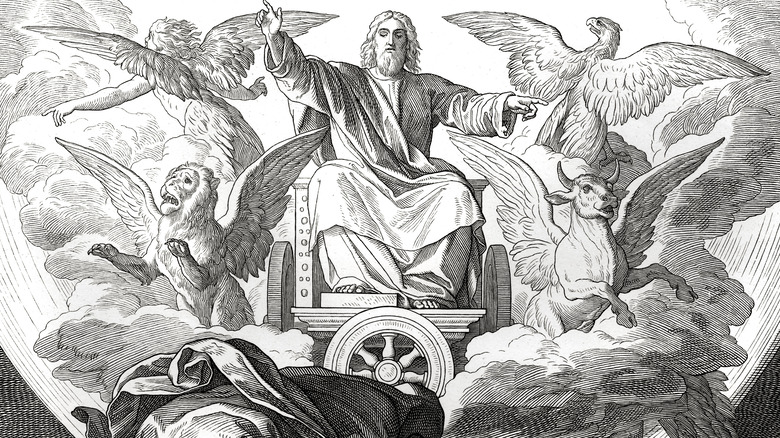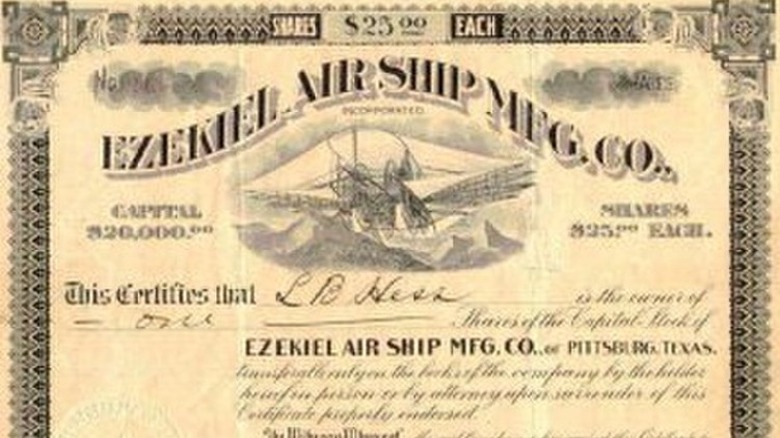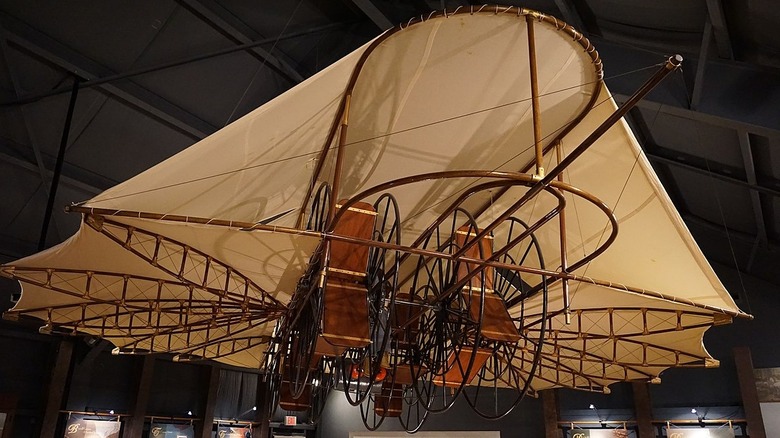The Flying Machine Built By A Baptist Minister
Although the awareness of the world that the internet brings can be a double-edged sword, it does allow us to access the histories of all kinds of strange and often overlooked nooks of history. The curious tale of Ezekiel's Airship is one such example. A surreal combination of prophecies, divinities, aviation aspirations, and historical preservation that begs the question: Where do facts often end and myths begin?
The Book of Ezekiel in the Old Testament is one of the more colorful stories in the Bible. Ezekiel was the third of the Old Testament's major prophets, notable for raising the dead and prophesying about the end of captivity for the children of Israel and the restoration of Jerusalem, as well as the destruction of the great city of Tyre (via Jewish Encyclopedia). One of the most memorable moments in the Book of Ezekiel occurs at the onset. Ezekiel is going about his business when God appears to him from the heavens, seated on a hovering chariot surrounded by two types of fearsome angels: winged cherubim and ophanim. Ezekiel's descriptions of the chariot, known as the merkava, and the ophanim angels as levitating, eye-covered wheels intersecting within wheels, has kept religious researchers and painters busy for millennia (per Britannica).
For some, these perplexing visions would spark centuries of intense theological debate; for others, they serve as proof of the first UFO sightings and spaceships (per Gaia). For one man, the Reverend Burrell Cannon, this chapter became a source of inspiration and a calling.
'Scuse me while I kiss the sky
Reverend Burrell Cannon was born in Mississippi but relocated to the cotton town of Pittsburg, Texas in the late 1800s. He managed to lead a Baptist church, run a sawmill, and tinker with the prototype for Ezekiel's airship all at the same time (per The Daily Press). Cannon's divine mission was to recreate the merkava from Ezekiel's vision. Cannon's airship, while not powered by angels, did have big fabric wings and a four-cylinder gas engine (per Scientific American).
Cannon raised $20,000 for the airship in 1901 by selling $25 stocks to his local flock, and the Ezekiel airship was finished the following year, in 1902 (via Bullock Museum). While the Wright brothers famously took the first step in mankind's eventual conquest of the skies in North Carolina in 1903, local legend claims that Cannon's Ezekiel Airship was actually the first to take flight, one year earlier.
While Cannon was preoccupied, Gus Stamps, a foundry worker who helped build the flying vehicle, decided to take the airship for a joyride. According to undocumented testimonies, Stamps started the engine and the airship soared to a height of 15 feet. It traveled 167 feet before landing safely in a field after soaring over a fence. Stamps then quickly shut off the power, presumably satisfied with carrying out the world's first plane hijacking (per Bullock Museum). Everyone who witnessed this must have taken a vow of silence, as there are no records of it, yet elder Pittsburg residents swear that this story is true (via CNN). Classic, right?
Eventual fate of the Ezekial Airship
Cannon was successful in getting major newspaper coverage for the airship. The airship was covered in a 1901 issue of Scientific American, which includes the only surviving photograph of the Ezekiel Airship. Cannon was so eager to demonstrate the superiority of his airship that he sent it by train to the 1904 World's Fair in Louisiana. The Almighty, on the other hand, might have had other plans. A terrible storm destroyed the airship in transit (per Bullock Museum). Cannon, naturally crushed, persevered and attempted to build another airship in his later years. However, his blueprints were destroyed in a fire in 1922, prompting Cannon to give up and devote his final days to inventing a "cotton picker and boll weevil destroyer" (via CNN).
In 1987, a Pittsburg resident rebuilt the plane using the surviving photo from Scientific American. This replica, on the other hand, weighed around 2,000 pounds, making it about five times heavier than Cannon's original. Following that, Ezekiel's airship was used as a decoration at a local Hot Links restaurant before being relocated to the city's Northeast Texas Rural Heritage Center and Museum, where it remains on display alongside Cannon's old Bible (via YouTube).


